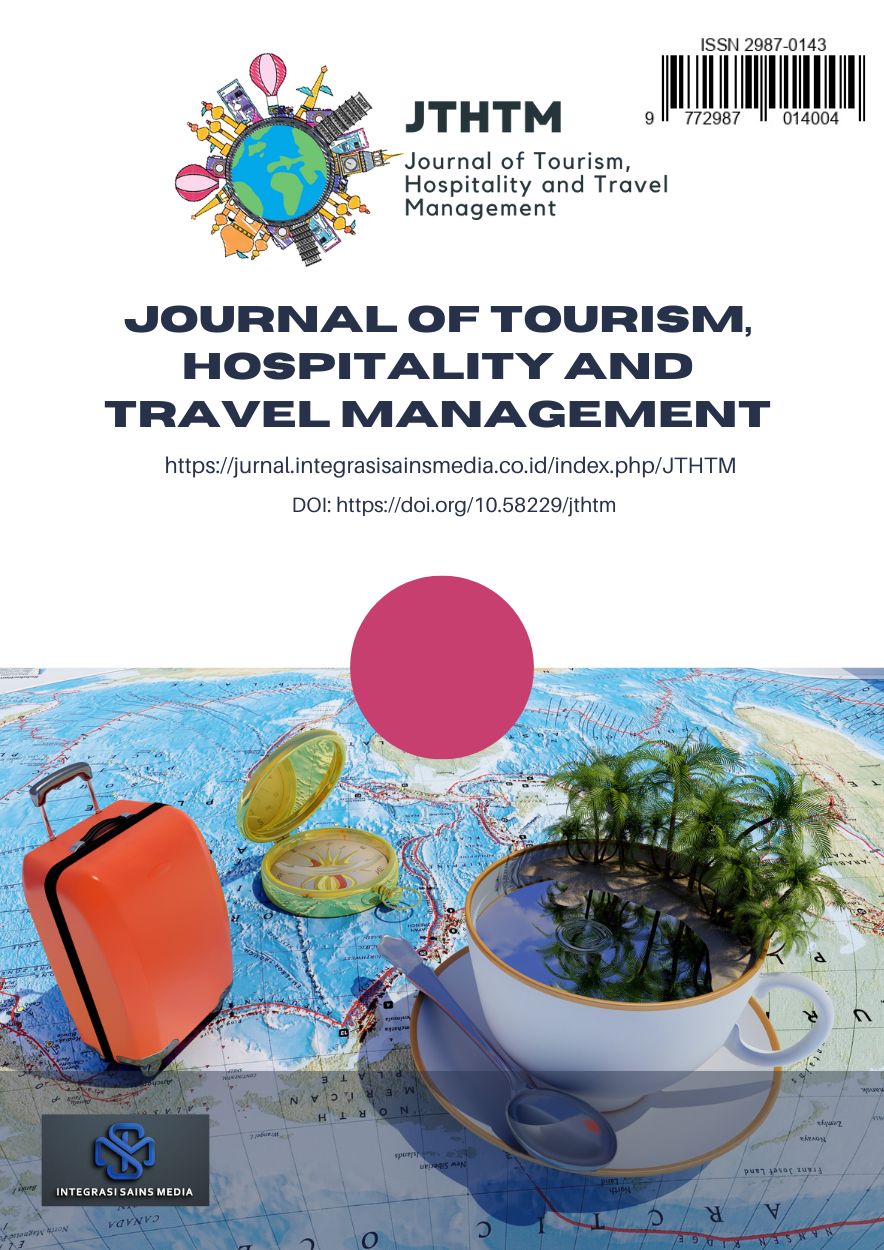Navigating Digital Trust: How Service Quality and Brand Image Shape Loyalty in Online Travel Platforms
DOI:
https://doi.org/10.58229/jthtm.v1i2.306Keywords:
online travel platforms, customer trust, perceived value, brand image, service quality, digital consumer behaviorAbstract
In the rapidly expanding digital travel ecosystem, understanding the drivers of customer loyalty has become essential for online travel platforms (OTPs) operating in competitive markets. This study investigates the effects of service quality, brand image, and perceived value on customer trust, satisfaction, and loyalty among Indonesian users of OTPs. Drawing on relationship marketing theory and the technology acceptance framework, a conceptual model was tested using data collected from 243 respondents via an online survey. Structural Equation Modeling with Partial Least Squares (PLS-SEM) was employed to assess measurement and structural models. The findings reveal that service quality, brand image, and perceived value significantly influence trust, positively affecting satisfaction and loyalty. Satisfaction also serves as a strong direct predictor of loyalty. Furthermore, perceived value impacted trust and satisfaction, highlighting its dual role in enhancing user engagement. The study contributes theoretically by integrating trust-based and value-driven constructs in a single model while offering practical insights for platform managers to enhance user retention through consistent service delivery, strong brand positioning, and value-oriented experiences.
References
Abdulkareem, A. K., & Oladimeji, K. A. (2024). Cultivating the Digital Citizen: Trust, Digital Literacy and E-Government Adoption. Transforming Government People Process and Policy, 18(2), 270–286. https://doi.org/10.1108/tg-11-2023-0196
Amin, M., Rezaei, S., & Abolghasemi, M. (2014). User Satisfaction With Mobile Websites: The Impact of Perceived Usefulness (PU), Perceived Ease of Use (PEOU) and Trust. Nankai Business Review International, 5(3), 258–274. https://doi.org/10.1108/nbri-01-2014-0005
Aswad, I. N., Prayudi, P., & Rochayanti, C. (2023). Digital Branding Communication Model for the Yogyakarta “JIH” Hospital Managed by the Digital Creative Agency, Kotakmedia Indonesia. Commicast, 4(2), 1–25. https://doi.org/10.12928/commicast.v4i2.8592
Davis, F. D. (1989). Perceived Usefulness, Perceived Ease of Use, and User Acceptance of Information Technology. JSTOR, 13(3), 319–340. https://doi.org/10.5962/bhl.title.33621
Dogra, N., & Adil, M. (2022). Should We or Should We Not? Examining Travelers’ Perceived Privacy, Perceived Security and Actual Behavior in Online Travel Purchases. Journal of Vacation Marketing, 30(1), 123–142. https://doi.org/10.1177/13567667221122103
Filieri, R., Açikgöz, F., Ndou, V., & Dwivedi, Y. K. (2020). Is TripAdvisor Still Relevant? The Influence of Review Credibility, Review Usefulness, and Ease of Use on Consumers’ Continuance Intention. International Journal of Contemporary Hospitality Management, 33(1), 199–223. https://doi.org/10.1108/ijchm-05-2020-0402
Ghaderi, Z., Abadi, R. S. S., & Qezelbash, A. H. (2020). Analysis of the Relationship Between the Quality of Presence of Destination Through Online Travel Contexts, Attitude, and Intention; Case of Iran. Journal of Tourism Management Research, 7(2), 229–246. https://doi.org/10.18488/journal.31.2020.72.229.246
Häfner, F., Härting, R.-C., & Kaim, R. (2020). Potentials of Digital Approaches in a Tourism Industry With Changing Customer Needs – A Quantitative Study. https://doi.org/10.15439/2020f102
Hallikainen, H., Hirvonen, S., & Laukkanen, T. (2019). Perceived Trustworthiness in Using B2B Digital Services. Industrial Management & Data Systems, 120(3), 587–607. https://doi.org/10.1108/imds-04-2019-0212
Hartanti, F. T., Abawajy, J., Chowdhury, M., & Shalannanda, W. (2021). Citizens’ Trust Measurement in Smart Government Services. Ieee Access, 9, 150663–150676. https://doi.org/10.1109/access.2021.3124206
Hatane, M. Y., Yosari, A., & Hendautomo, F. C. (2012). Evaluation of the Successfulness of a Green Program Through Customer Perceived Quality, Brand Image, and Customer Satisfaction: A Case Study at Surabaya Plaza Hotel. Jurnal Manajemen Dan Kewirausahaan, 14(1). https://doi.org/10.9744/jmk.14.1.56-63
Iqbal, M. (2022). The Influence of Brand Image and Service Quality on Customer Value and Its Implications on Customer Satisfaction (Case Study of PT XL Axiata Tbk). International Journal of Research and Review, 9(6), 496–507. https://doi.org/10.52403/ijrr.20220653
Kim, M., & Kim, J. (2019). Destination Authenticity as a Trigger of Tourists’ Online Engagement on Social Media. Journal of Travel Research, 59(7), 1238–1252. https://doi.org/10.1177/0047287519878510
Kotler, P., & Keller, K. L. (2016). Marketing Magement. In Pearson Education Limited (15th Globa). Pearson Education Limited.
Kurniasari, F. (2021). The Factors Affecting the Adoption of Digital Payment Services Using Trust as Mediating Variable. Emerging Markets Business and Management Studies Journal, 8(1), 15–24. https://doi.org/10.33555/embm.v8i1.165
Kurniasari, F., Gunawan, D., & Utomo, P. (2022). Factors Influencing Small Medium Enterprise’s Behavior in Adopting E-Fulfillment Services. International Journal of Professional Business Review, 7(2), e0550. https://doi.org/10.26668/businessreview/2022.v7i2.550
Kurniasari, F., Urus, S. T., Utomo, P., Hamid, N. A., Jimmy, S. Y., & Othman, I. W. (2022). Determinant Factors of Adoption of Fintech Payment Services in Indonesia Using the UTAUT Approach. Asia-Pacific Management Accounting Journal, 17(1), 97–125. https://doi.org/10.24191/apmaj.v17i1-04
Mukherjee, A., & Nath, P. (2007). Role of Electronic Trust in Online Retailing. European Journal of Marketing, 41(9/10), 1173–1202. https://doi.org/10.1108/03090560710773390
Ningrum, D. A., Rizan, M., & P, A. K. R. (2021). The Effect of Service Quality and Brand Image on Repurchase Intention With Brand Trust as Mediating Variable by the Generation Z of E-Wallet Consumers in Jakarta. Journal Research of Social Science Economics and Management, 1(4), 336–356. https://doi.org/10.36418/jrssem.v1i4.29
Octaviani, R. D., Sucherly, S., Prabowo, H., & Sari, D. (2023). Determinants of Indonesian Gen Z’s Purchase Behavior on Online Travel Platforms: Extending UTAUT Model. Innovative Marketing, 19(4), 54–65. https://doi.org/10.21511/im.19(4).2023.05
Parasuraman, A., Zeithaml, V. A., & Berry, L. L. (1988). SERVQUAL: A multiple-item scale for measuring consumer perceptions of service quality. Journal of Retailing, 64(1), 12–40.
Permatasari, R. D., Rohman, F., & Prabandari, S. P. (2022). The Antecedents of Repurchase Intention at User Online Travel Agents in Indonesia Mediated by Brand Image. International Journal of Research in Business and Social Science (2147-4478), 11(9), 67–76. https://doi.org/10.20525/ijrbs.v11i9.2194
Prawira, M. F. A., Susanto, E., Goeltom, A. D. L., & Furqon, C. (2022). Developing Cashless Tourism from a Tourist Perspective: The Role of TAM and AMO Theory. Journal of Environmental Management and Tourism, 13(8), 2104. https://doi.org/10.14505/jemt.v13.8(64).03
Prawira, N. G., Susanto, E., Fitriani, M., & Prawira, A. (2023). Visual Branding on Indonesian Tourism Destinations : Does It Affect Tourists ? ABAC Journal, 43(1), 1–17. https://doi.org/10.14456/abacj.2023.4
Radwan, A. F., Snoussi, T., Mousa, S. A., & Abdulzaher, M. (2023). Using Smart Applications in Delivering Government Services in the UAE. International Journal of Service Science Management Engineering and Technology, 14(1), 1–15. https://doi.org/10.4018/ijssmet.326520
Rithmaya, C. L., Ardianto, H., & Sistiyarini, E. (2024). Gen Z and the Future of Banking: An Analysis of Digital Banking Adoption. Jurnal Manajemen Dan Kewirausahaan, 26(1), 64–78. https://doi.org/10.9744/jmk.26.1.64-78
Rodi, R., Ahmad, S., & Rahman, F. M. (2023). The Influence of Service Quality, Product Quality and Trust on Customer Loyalty of CV. Ferdi Mandiri. Journal of Economics Finance and Management Studies, 06(12). https://doi.org/10.47191/jefms/v6-i12-13
Shao, T., & Kenney, M. (2018). Ctrip: China’s Online Travel Platform Local Giant or Global Competitor? SSRN Electronic Journal. https://doi.org/10.2139/ssrn.3153836
Statista. (2023). Solo travelers - statistics & facts. Travel, Tourism & Hospitality. https://www.statista.com/topics/9322/solo-travelers/#topicOverview
Statista Research Department. (2024). Online Travel Market Size Worldwide From 2017 to 2023, With a Forecast Until 2029. Leisure Travel. https://www.statista.com/statistics/1179020/online-travel-agent-market-size-worldwide/
Su, Y.-Y., Paradis, K., & Kuo, Y. (2023). Indonesian Generation Z Embrace Digital Payments for Convenience and Discounts. 671–683. https://doi.org/10.2991/978-2-38476-052-7_73
Susanto, E., & Bonita, M. S. (2022). Application of Technology Acceptance Model on Electronic Book Design of Bandung City History Travel Guide. Barista : Jurnal Kajian Bahasa Dan Pariwisata, 9(1), 1–14. https://doi.org/10.34013/barista.v9i01.697
Susanto, E., Hendrayati, H., Rahtomo, R. W., & Prawira, M. F. A. (2022). Adoption of Digital Payments for Travelers at Tourism Destinations. African Journal of Hospitality, Tourism and Leisure, 11(2), 741–753.
Susanto, E., Solikin, I., & Purnomo, B. S. (2022). A REVIEW OF DIGITAL PAYMENT ADOPTION IN ASIA. Advanced International Journal of Business, Entrepreneurship and SMEs, 4(11), 01–15. https://doi.org/10.35631/AIJBES.411001
Tamara, D., Maharani, A., Heriyati, P., Rienaldy, A., Ramadhan, A. F., Rizky, D., & Widyawan, W. (2023). Analysis of Consumer Reuse Intention for Digital Healthcare Application Using the Extended TAM Approach. E3s Web of Conferences, 426, 1006. https://doi.org/10.1051/e3sconf/202342601006
Topbaş, A., & Oktay, K. (2024). Casting a Digital Spell: How Socialmediainfluencers Shape Destination Marketing. Bdu, 1(13), 193–200. https://doi.org/10.55956/fteg9814
Upamannyu, N. K. (2014). Effect Of Brand Image On Customer Satisfaction, Loyalty Intention And The Role Of Customer Satisfaction Between Brand Image And Loyalty Intention: A Study In Context Of Cosmetic Product. Journal of Social Science Research, 3(2), 274–285. https://doi.org/10.24297/jssr.v3i2.3119
Velsen, L. v., Tabak, M., & Hermens, H. (2017). Measuring Patient Trust in Telemedicine Services: Development of a Survey Instrument and Its Validation for an Anticoagulation Web-Service. International Journal of Medical Informatics, 97, 52–58. https://doi.org/10.1016/j.ijmedinf.2016.09.009
Wang, Y. (2024). Research on Marketing Strategies in the Online Tourism Market in the Internet Age. Highlights in Business Economics and Management, 39, 867–873. https://doi.org/10.54097/gb4nj417
Wu, A., & Dahlan, K. S. S. (2023). The Impact of Digital Trust on Customer Satisfaction and Loyalty (The Case of Digitalization in Container Shipping Services in Indonesia). Opsearch American Journal of Open Research, 2(12), 816–827. https://doi.org/10.58811/opsearch.v2i12.87
Xi, Y., Ali, N. A., & Tat, H. H. (2024). The Mediating Role of Electronic Personalization in Online Travel Platform: A Conceptual Framework. International Journal of Academic Research in Business and Social Sciences, 14(5). https://doi.org/10.6007/ijarbss/v14-i5/21311
Xiao, Q., Li, S., Zhang, X., Zhang, F., Yue, Q., & Wan, S. (2021). Deconstructing Online Hospitality Review Systems. Journal of Organizational and End User Computing, 34(2), 1–17. https://doi.org/10.4018/joeuc.292523
Yang, X., Zhang, X., Goh, S., & Anderson, C. (2017). Curvilinear Effects of E-Loyalty in China’s Online Tourism Industry. Nankai Business Review International, 8(2), 174–189. https://doi.org/10.1108/nbri-12-2016-0044
Zeithaml, V. A. (1988). Consumer Perceptions of Price, Quality, and Value: A Means-End Model and Synthesis of Evidence. Journal of Marketing, 52(3), 2. https://doi.org/10.2307/1251446
Zhang, Y. (2023). Analysis of the Digital Transformation Development Path for Travel Enterprises. Open Journal of Applied Sciences, 13(08), 1370–1386. https://doi.org/10.4236/ojapps.2023.138109
Літовцева, В., Krawczyk, D., Kuzior, A., Brychko, M., & Vasylieva, T. (2022). Marketing Research in the Context of Trust in the Public Sector: A Case of the Digital Environment. Innovative Marketing, 18(4), 133–147. https://doi.org/10.21511/im.18(4).2022.12






